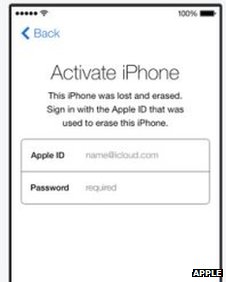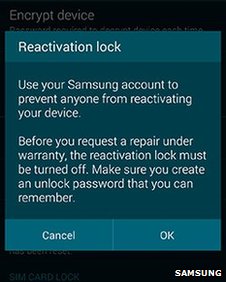- Apr 24, 2013
- 1,200
- Content source
- http://www.bbc.com/news/technology-31416846

The addition of "kill switch" anti-theft tools to iPhones and Android handsets appears to be acting as a major deterrent to criminals.
London, New York and San Francisco have all announced major drops in the number of reported stolen smartphones since the facilities were added.
A kill switch allows an owner of a stolen phone to send a command that blocks it from being accessed or reset until an ID and passcode are entered.
Microsoft has yet to add the feature.
Apple was first to introduce the measure. It included Activation Lock as an option in its iOS 7 operating system in September 2013, and the latest released statistics are based on iPhone thefts over the following 12 months:
- London reported a 50% fall in iPhone thefts
- San Francisco reported a 40% fall
- New York reported a 25% fall

Apple introduced a kill switch function in 2013
"We have made real progress in tackling the smartphone theft epidemic that was affecting many major cities just two years ago," said London Mayor Boris Johnson following the latest announcement.
San Francisco District Attorney George Gascon added: "Preventing their own customers from being the target of a violent crime is the coolest technology [the mobile industry] can bring to market."
Default protection
The authorities are still pressing for further change.
Although Apple made its kill switch the default setting on new iPhones running iOS 8 - meaning users do not need to switch it on, but rather must switch it off if they do not want it - this is not the case for other devices.
So, while Google announced in October that its Android Lollipop operating system would introduce an opt-in feature called Factory Reset Protection, it is not currently offered by all handsets running the system.
Likewise, Samsung's proprietary Reactivation Lock facility, offered on some of its Galaxy S5 smartphones, must also be turned on manually.

Samsung was the first Android manufacturer to support a kill switch
The SOS initiative, however, is calling for kill switches to be automatically activated on every mobile device.
"A default solution is imperative because it ensures all device are worthless to thieves," a campaign leaders said.
Microsoft has promised to incorporate a kill switch into its smartphone version of Windows 10, but has yet to announce when the OS will be released.
Smartphone chip maker Qualcomm has also announced a hardware-based kill switch facility, to be called SafeSwitch, that it will offer to manufacturers that use its latest processors.
The firm describes this as a "superior solution" to others' software-based efforts.
But handset-makers have yet to say if they will make the facility available to consumers.
